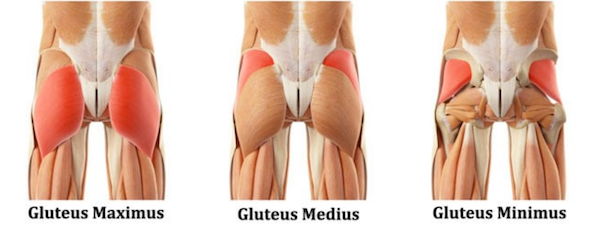The Kettlebell RDL
Also known as the kettlebell Romanian deadlift, the kettlebell RDL is an essential exercise for building strength in your hamstrings and glutes.
Not only will this exercise increase your lower body strength, it will help you prevent injury and improve your performance in other exercises. In this article, we cover all you need to know about the kettlebell RDL.
Muscles Worked By The Kettlebell RDL
Primary Muscle Groups:
The kettlebell Romanian deadlift engages the four muscles in the back of your leg that comprise the hamstring: the biceps femoris (a group of two muscles: long and short head), semitendinosus, and the semimembranosus.
During this hamstring kettlebell exercise, you should feel a deep stretch in these muscles.

The gluteal muscles are a group of three muscles: the gluteus maximus, medius, and minimus.
While the kettlebell RDL targets this group as a whole, it especially works the gluteus maximus, which is the largest of the three muscles.

Secondary Muscle Groups:
The kettlebell RDL is an effective compound exercise, as it activates muscles throughout the body. This exercise secondarily works your core muscles, as your abdominals and obliques contract to stabilize your mid-section.
In addition, your traps, forearms, and mid-lower back activate to control the weight during the exercise motion.
Kettlebell RDL Benefits
1. Bigger & Stronger Glutes And Hamstrings
The kettlebell RDL places a ton of tension on your glutes and hamstrings, which generates mechanical damage to the muscle fibers. As a result, your individual muscle cells grow through a process called hypertrophy.
With greater muscle mass, not only will your lower half look more defined, but you will be able to improve your performance in other lifts such as the barbell squat and the deadlift.
2. Improved Athletic Performance
Adding the kettlebell RDL to your workout regimen can help improve your athletic performance. Walking, running, jumping, and other athletic movements all depend upon hip strength, endurance, and form.
The kettlebell Romanian deadlift increases the strength and stability of your glutes and hamstrings. This will only improve your performance in any athletic competition.
3. Convenience
Unlike other lower body exercises like the seated leg press or the glute ham raise, the kettlebell RDL doesn’t depend on any gym equipment to make major gains.
Instead, all you need is a kettlebell and an open space.
With that being said, let’s delve into the mechanics of this exercise.
How To Do The Kettlebell RDL
Equipment:
For this hamstring kettlebell exercise, you will need a kettlebell.
Setup:
a) Set up a kettlebell on the ground in front of you.
b) Assume a standing position with your feet shoulder width apart.
c) Hinge at the waist and bend your knees so that your back is roughly parallel to the floor.
d) Grab the handle of the kettlebell with your palms facing towards you.
e) Lift the kettlebell up to a standing position.
Action:
a) With a slight bend in your knees, hinge at the waist with a straight back and slowly lower the kettlebell towards the ground. You should feel a deep stretch in your hamstrings as your hips move backwards.
b) Pause for a moment at the bottom and reverse the motion as you return to the standing position. Squeeze your glutes hard in this position.
c) Maintain tightness in your core and repeat!

Recommendation:
If you are new to the kettlebell RDL, choose a light weight to begin and complete 3-4 sets of 10-12 reps.
If you are more comfortable with the form, grab a heavier kettlebell and complete 6-8 reps for 3-4 sets.
Kettlebell RDL Mistakes
1. Rounding Of The Back
Rounding the back is the most common mistake made during the kettlebell RDL. A rounded back can lead to strained back muscles and reduced tension on your lower half.
Before hinging at the waist, pinch your shoulder blades together to keep your back straight and tighten your core to keep your abs engaged. This will greatly reduce your risk of injury during the kettlebell RDL.
2. Rushing The Motion
The kettlebell RDL emphasizes the eccentric portion of the exercise when the hamstrings are lengthening. For that reason, it is crucial to do this exercise slowly to maximize the tension on your lower body.
When people rush through the RDL, they usually are trying to lift too much weight. Instead, lift a comfortable weight and complete each rep slowly.
Not only will this increase your gains, but it will improve your mind-muscle connection as well!
3. Completing Partial Reps
When doing the kettlebell RDL, it is extremely important to lower the kettlebell as far as your hamstrings allow.
Some lifters stop lowering as soon as they feel tension in their hamstrings. Truth be told, lowering the kettlebell to knee level is a partial rep.
While you should always stop lifting if you feel significant pain or instability, push yourself to go as low as you can on each rep to maximize your gains!
Kettlebell RDL Variations
1. Dumbbell Romanian Deadlift
The dumbbell Romanian deadlift is a great variation of the kettlebell RDL. If you feel more comfortable holding two dumbbells rather than one kettlebell, give the dumbbell RDL a try, making sure to keep the same form as the kettlebell variation.

2. Single Leg Kettlebell RDL
You can use the single leg RDL to train your legs unilaterally as well.
Begin by grabbing one kettlebell with both hands and assuming a standing position with your feet close together. Place all of your weight on one foot and balance in this position. Engage your core and bring your shoulder blades back and down.
While keeping your back straight, sit your hips back and begin to bend forward and bring the kettlebell down towards the floor. *Note* — While your planted leg should remain nearly straight, you can allow your trail leg to bend slightly.
Keep leaning forward until your back is roughly parallel to the floor. You should feel a deep stretch in your hamstring. Now, reverse the motion as you return to the standing position and squeeze your glutes. Maintain tightness in your core and repeat!

3. Barbell RDL
The barbell RDL provides an opportunity to add on some more weight to challenge yourself.
Begin by setting up a barbell on the ground with light to medium weight.
Hinge at the waist and bend your knees so that your back is roughly parallel to the floor. Grab the bar with your palms facing towards you and your hands slightly wider than shoulder width apart.
Lift the barbell up to a standing position.
Next, complete the barbell RDL with the same form as the kettlebell variation!

Kettlebell RDL Alternatives
If you enjoyed the kettlebell RDL, check out these alternative leg and glute exercises to improve your lower body training:
1. Kettlebell Alternating Lunge
Grab a kettlebell in your right hand with a neutral grip and assume a standing position with your feet roughly shoulder width apart.
Engage your core and step forward with your right leg and lunge down until your left knee touches the ground. Be sure to keep your right knee directly over your right ankle.
Then, explode back up to the starting position, pass the kettlebell to your left hand, and repeat the lunge on the left side. Keep alternating sides and be sure to keep your core tight!

2. Nordic Hamstring Curl
Begin by kneeling on both knees with your back straight. Secure your ankles with a piece of equipment or have your partner hold them in place. Tighten your hamstrings, glutes, and abs.
Keeping your back straight, slowly lean forward until you reach the floor. *Note — most people cannot control the movement all the way down. Lean forward as far as you can until you fall forward and catch yourself.
Squeeze your hamstrings to raise your body back to the starting position. Feel free to push yourself up off the ground if you need an initial boost. Squeeze hamstrings and glutes hard at the top to maximize the contraction. Repeat!

3. RFE Split Squat
Begin by placing your trail foot on the elevated surface behind you. Step outwards with your lead foot so that your trail leg is slightly bent.
Lean slightly forward and keep your back straight. Engage your core and squat downwards into your front leg. Pause for a moment at the bottom of the rep and drive upwards with your lead leg.
Maintain tightness in your core and repeat!

Looking For A Full Leg Workout?
Follow along to this intense 5-minute kettlebell leg workout!
Join the Invasion!
This Anabolic Aliens membership will grant you access to workout classes, rehab programs, diet plans, and more exclusive content to help you achieve sustainable success!










